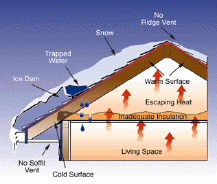|

|
|
 A lot of homeowners don't know what ice dams are --
until it's too late. A lot of homeowners don't know what ice dams are --
until it's too late.
Ice dams are most common in northern climates. They occur when heavy
snow buildup melts during the day and then refreezes when temperatures
drop overnight.
After several days of melting-freezing cycles, it's common for the melted
water and ice to work up under the shingles until water enters the attic
and eventually does damage to the ceilings, wall and contents. In cases
where the ice dam goes unnoticed for an extended period of time, it
can do significant damage to the building and its contents.
There's no way to guarantee an ice dam won't damage your home, but you
can take steps to cut the chances of an ice dam forming in the first
place:
- If you haven't already, thoroughly clean all leaves,
sticks and other debris from your home's gutters and down spouts.
This lets melting roof snow flow into gutters and through down spouts,
just as they were designed.
- Make every effort to keep snow on your roof to a
minimum. Long-handled devices on the market called "roof rakes"
let you stand on the ground and pull the snow off the roof. Keeping
heavy snow loads off your roof reduces the chances for both ice dam
formation and roof failure due to the weight.
- All winter long, keep gutters and down spouts clear
of snow and icicles.
- Evaluate the insulation and ventilation in your attic.
Most experts agree the R-value of attic insulation should be at least
R-30 (R-38 is preferable in northern climates). In addition, good
airflow from under the eaves or soffit area along the underside of
the roof and out through the roof vents is essential to a cool, dry
attic. Consult a reputable roofing and/or insulation contractor about
these improvements.

Prevent Frozen Pipes
If you think turning the heat down in your home while
you're away on vacation will save you a few dollars, think again. If
your home's pipes should freeze and burst, it could end up costing thousands
of dollars to repair floors and replace furniture and keepsakes. The
damage could be so severe that you and your family would have to relocate
while repairs are made.
By taking a few simple precautions, you can save yourself a ton of aggravation.
Here are a few simple steps to protect your home or apartment:
- Insulate pipes in your home's crawl spaces and attic.
Exposed pipes are most susceptible to freezing.
- Heat tape or thermostatically controlled heat cables
can be used to wrap pipes. Be sure to use products approved by an
independent testing organization, such as Underwriters Laboratories
Inc., and only for the use intended (exterior or interior).
- Seal leaks that allow cold air inside. Look for air
leaks around electrical wiring, dryer vents and pipes. Use caulk or
insulation to keep the cold out and the heat in.
- Disconnect garden hoses and, if practical, use an
indoor valve to shut off and drain water from pipes leading to outside
faucets.
- When you're away from home, set the thermostat
in your house no lower than 55 degrees. Ask a friend to stop by
your house daily to make sure it's warm enough to prevent freezing,
or shut off and drain the water system.

Here are a few additional helpful tips from the National
Association of Remodelers:
- Make sure your furnace is in good working order for
the cold spurts. Check that the furnace filter is clean and replace
it if it's not. Ensure that the thermostat and pilot light are working
properly and that the pipe bringing fuel to your furnace isn't leaking
or loose.
- Have your heating ducts cleaned. It's recommended
that the ducts be vacuumed every five years.
- Check the caulking around doors and windows to make
sure there's no cracking or peeling. Recaulking if needed prevents
cold air from entering your home. Why pay a higher heating bill if
you don't have to?
- Keep snow and ice from building up around the bottom
of the garage door so it closes completely and doesn't warp.
- Frozen water pipes can quickly crack followed by
gallons of water all over your home. Prevent this by draining your
pipe's hose bibs and by keeping your heat on even when you're away
from home.
- Safely drain and properly dispose of the gasoline
from lawnmowers, weedwackers, and other engines that won't be used
until summer.

Learn More...
Overview
| Understanding The
Basics | Types Of
Insurance | Coverage
Amounts
Choosing A
Policy | Filing
A Claim | Other
Types Of Insurance | Home
Safety Tips
Planning
Concerns | Home
Glossary

Please Note: The
information contained in this Web site is provided solely as a source of
general information and resource. It is a not a statement of
contract and coverage may not apply in all areas or circumstances. For a complete
description of coverages, always read the insurance policy, including
all endorsements.
|

 A lot of homeowners don't know what ice dams are --
until it's too late.
A lot of homeowners don't know what ice dams are --
until it's too late.